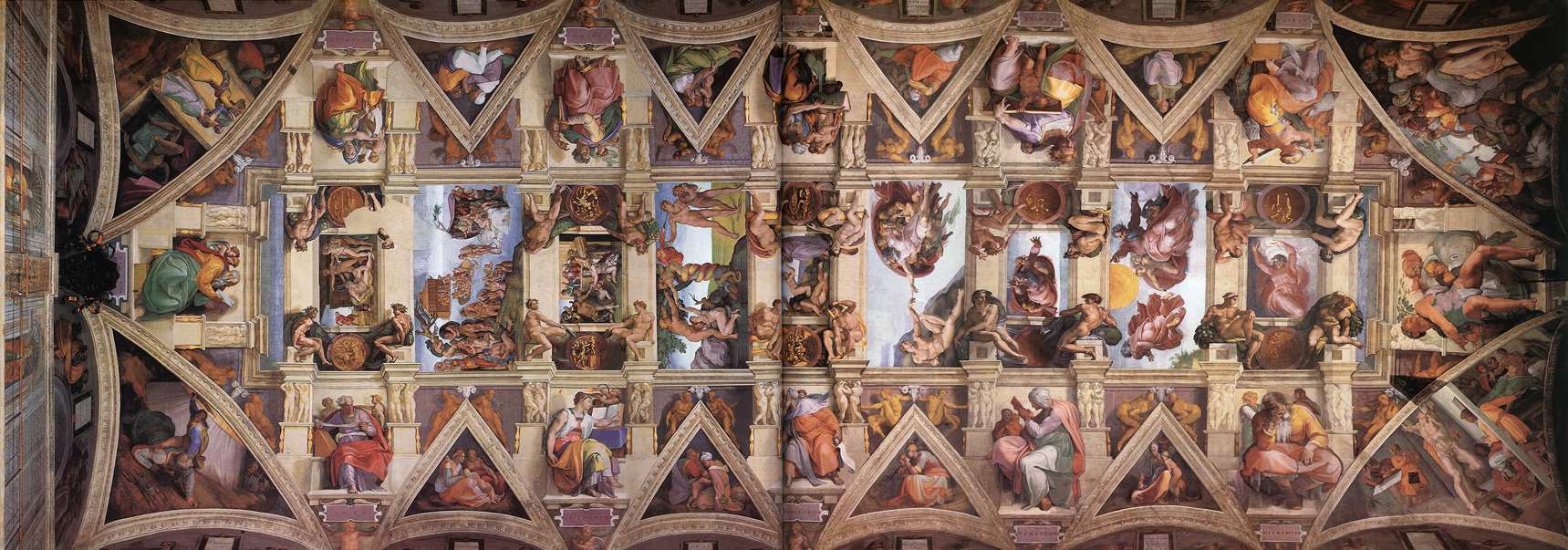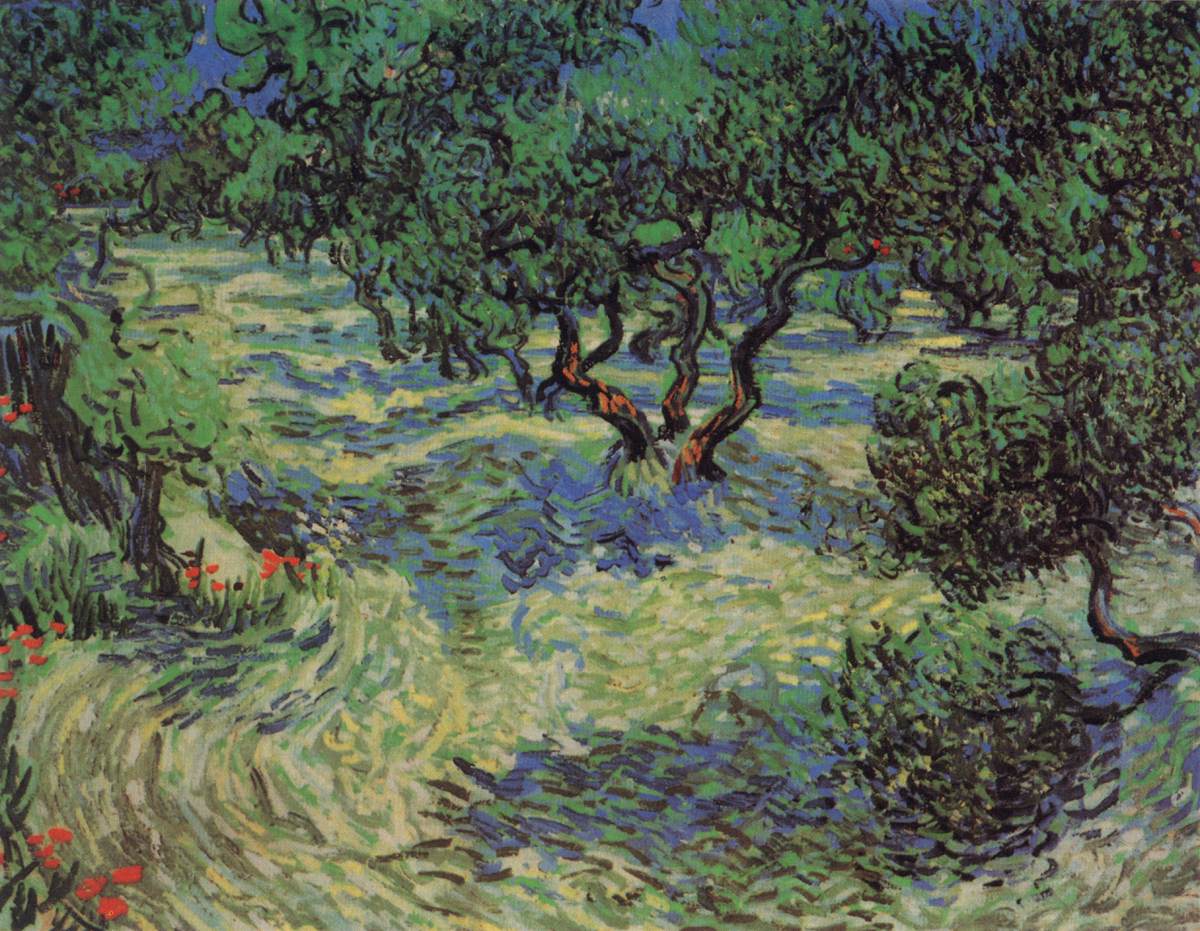Random inspiration
This is a random selection from the database to inspire you! If you need new inspiration, just hit refresh!
The ceiling
MICHELANGELO Buonarroti
In the scheme of divisions, the key elements are the thrones of the seers flanked by plinths and colonnettes decorated with pairs of putti supporting the cornice running above the crowns of the spandrels, at about a third of the way across the curve of the vault. Beyond the cornice, the vertical frames flanking the thrones are prolonged as the arches crossing the vault. They divide it into nine compartments in which the stories of Genesis - from the Separation of Light from Darkness to the Drunkenness of Noah - are represented as if they were seen above the space of the chapel, beyond and through the imposing structure of the painted architecture.
In the five compartments above the thrones, the field of the narrative scenes is limited in size by the presence of four figures of ignudi, sitting on plinths and bearing garlands of oak leaves and acorns, and of two medallions painted to resemble bronze, with episodes drawn from the books of Genesis, Samuel, Kings, and Maccabees.
Lastly, under the cornice and the thrones, in the spandrels and the lunettes at the tops of the walls, are depicted the forty generations of the Ancestors of Christ, from Abraham to Joseph, while the corner pendentives contain representations of biblical scenes associated with the theme of the divine protection of the Jews: Judith and Holofernes, David and Goliath, the Brazen Serpent, and the Punishment of Haman.
Dante and Virgil in the Underworld
NAPOLETANO, Filippo
The subject of the painting, depicting odd skeletal creatures, is inspired by Dante’s Divine Comedy, in which the author describes his visit to the underworld with Virgil. Two standard features of Dante’s Hell are included: Charon’s boat, and Cerberus, the three-headed dog who guards the underworld. The huge arched structure is based on the ruins of the Basilica of Maxentius, making it likely that the picture was painted in Rome.
Portrait of Giovanni II Bentivoglio
ROBERTI, Ercole de'
The subject of this painting, a companion-piece to the portrait of his wife Ginevra Bentivoglio, was ruler of Bologna for thirty-three years. Quattrocento portraits were expected to trace with cartographic precision exact physical appearences. Profile portraits were probably preferred because they recall imperial likenesses on ancient Roman coins.
Sleeping Cupid
CARACCIOLO, Giovanni Battista
The canvas depicts an adolescent, seemingly a sleeping Cupid stretched out on a crimson damask bedspread and pillow trimmed with dark ochre braiding and tassels. A bow and arrow are set on them in the foreground, the tip of the arrow tucked into the folds of the spread.
The most plausible names scholars have advanced so far for the attribution of the work are Orazio Riminaldi and Giovanni Battista Caracciolo. Currently the latter is the most convincing.
View of the park
ERDMANNSDORFF, Friedrich Wilhelm von
The park at W�rlitz incorporates many influences from Kew, near Richmond, Rousham (Oxfordshire), Stourhead (Wiltshire) and Stowe (Buckinghamshire), and was an attempt to create England-by-the-Elbe, as an exemplary and educational programme to raise the tone of the Principality to one of Enlightenment and Progress.
The photo shows the W�rlitz Lake with Amalie Grotto.
Hall of the Triumphs (detail)
GUALTIERO PADOVANO
This detail of the frescoes in the Hall of the Triumphs shows a landscape with the Ideal View of Rhodes (with the Colossus of Rhodes).
Napoleon Holding Josephine's Crown
DAVID, Jacques-Louis
While painting the Consecration, David was faced with the problem of selecting the most significant moment of the ceremony to commemorate. At first, he planned to show Napoleon raising Josephine’s crown above his own crowned head while pressing his ceremonial sword close to his heart. Although it is often said that this drawing and others show Napoleon crowning himself, it is known that he did not put on two crowns (itself a difficult task), and the crown he holds is certainly that of Josephine.
Ospedale degli Innocenti: Façade
BRUNELLESCHI, Filippo
The loggia that Brunelleschi designed for the hospital is not, in its basic form, unusual. This type of structure seems to have been used consistently in late medieval hospitals. Street loggias providing shelter for pedestrians were common in other Italian cities, particularly Bologna, Padua, and Venice.
Tomb of Michelangelo: Allegory of Architecture
BANDINI, Giovanni
Following the solemn funeral of Michelangelo held in the church of San Lorenzo on 14 July 1564, Vasari began his project for the structure of the monument to Michelangelo. The elaborate allegorical decoration for the project was drawn up by Vincenzo Borghini and included contributions by Battista Lorenzi, who sculpted the statue of Painting and the bust of Michelangelo, and Valerio Cioli the statue of Sculpture. The marble personification of Architecture was made by Giovanni Bandini.
Giovanni Bandini (known as Giovanni dell’Opera) achieved recognition early in his career. In 1563 he became a member of the newly established Accademia del Disegno in Florence and the following year was asked to create the personifications of Architecture and the Tiber for the catafalque of Michelangelo. Cosimo I was so impressed with these figures that he commissioned Bandini to execute the marble personification of Architecture for Michelangelo’s tomb. The figure was completed by 1568 but was installed only in 1574. Its solemn grandeur seems to owe much to Michelangelo’s Giuliano de’ Medici (New Sacristy, San Lorenzo, Florence).
The picture shows the lower part of Michelangelo’s tomb with Painting (left), Sculpture (centre) and Architecture (right).
Nessus and Deianira
PÉCHEUX, Laurent
The subject is taken from Ovid (Met. 9:101-133). On a journey, Hercules and Deianira came to a river where the centaur Nessus was the ferryman. While carrying Deianira across he attempted to ravish her. Hercules, already on the further bank, drew his bow and slew Nessus.
Design for a glass window
TOULOUSE-LAUTREC, Henri de
In 1894, he American painter and designer Louis Comfort Tiffany planned the production of glass windows based on designs created by French artists including Bonnard, Denis, Vallotton, and Toulouse-Lautrec. Just a year later the windows were presented at the Paris Salon on the Champ de Mars and at the opening of Bing’s gallery L’Art Nouveaux. Only a few are still in existence today, for example that based on the present design by Toulouse-Lautrec.
Beethoven's Room
HOECHLE, Johann Nepomuk
This drawing shows Beethoven’s study in the Schwarzspanierhaus - his final residence. Hoechle’s “portrait” of the room was made three days after the composer’s death. The idea was to preserve, in visual form at least, the way Beethoven’s last dwelling place had looked. In the drawing we can see one of the several versions of Beethoven’s bust (all plaster casts) placed on the right window ledge, made by the young sculptor Anton Dietrich (1796-1872). No marble copy was ever realized of the plaster casts.
 Suggested listening (streaming mp3, 6 minutes):
Suggested listening (streaming mp3, 6 minutes):
Ludwig van Beethoven: Die Gesch�pfe des Prometheus (The Creatures of Prometheus), overture op. 43
Crucifix between the Virgin and Saints
BARONCELLI, Niccolò
In 1450 Baroncelli was commissioned to make life-size bronze statues of the Crucified Christ, the Virgin, St John the Evangelist, St George and St Maurelius to be placed on an architrave before the high altar in Ferrara Cathedral (now in the right arm of the transept). With his son Giovanni he completed the first three statues, St George and St Maurelius were completed by Domenico di Paris.
Book of Hours of Étienne Chevalier
FOUQUET, Jean
The picture shows a miniature Martyrdom of St James the Great from the Book of Hours of �tienne Chevalier.
Tomb of Don Felipe and Doña Juana
ORDÓÑEZ, Bartolomé
Ord�nez worked first in Italy. In 1515 he was in Barcelona working on the choir of the cathedral. His well-composed reliefs and splendid marble panels, so severely monumental and harmonious, suggest the influence of Michelangelo. In about 1519 he must have executed the admirable tomb of Don Felipe and Doña Juana (Philip the Handsome and Joanna the Mad) in the Royal Chapel of Granada. A year later he died in Carrara, leaving behind him numerous admirers and imitators of his pure and noble style.
Exterior of the church
FRANCESCO DI GIORGIO MARTINI
Tuscan architects developing the principles laid down by Brunelleschi, constructed important churches in the last years of the 15th century. These include Santa Maria delle Carceri, at Prato, by Giuliano da Sangallo, and Santa Maria del Calcinaio, near Cortona, by Frencesco di Giorgio. Both these resemble the experiments with centrally planned churches being carried out in Milan by Leonardo and Bramente, and we know that Francesco di Giorgio was personally acquainted with Leonardo. In these churches we see the culmination of the Early Renaissance ideals of classical lightness and purity.
View the ground plan of Santa Maria delle Grazie al Calcinaio.



















